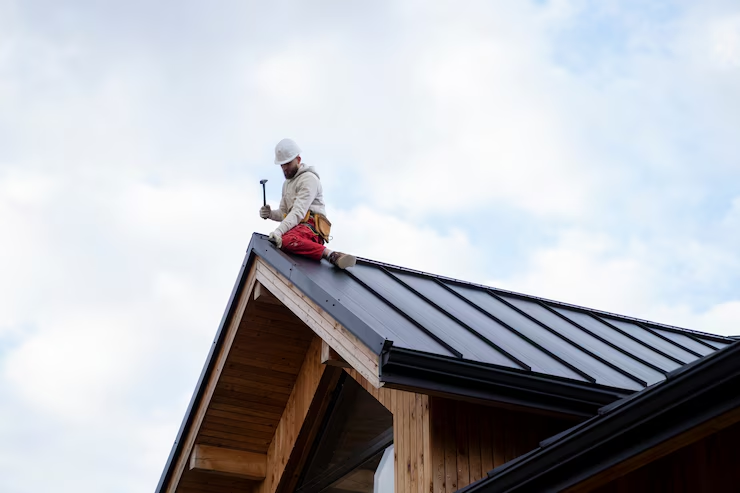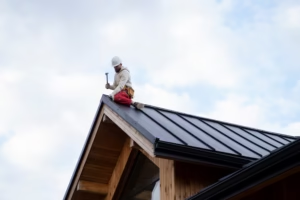A complete roof re-roofing is one of the most important investments you can make to ensure the protection, efficiency, and aesthetics of your home or building. A poorly maintained roof can lead to leaks, structural damage, and increased energy costs. In this article, we’ll explore everything you need to know about re-roofing, from the signs that it’s necessary to the available material options and the installation process.
fuente: freepik
When is a complete roof replacement necessary?
A worn or damaged roof can compromise the safety and comfort of your home. Here are some signs that you need to replace it:
1. Broken or missing tiles
Missing or cracked shingles allow water and air to enter, affecting the roof’s waterproofing and insulation.
2. Leaks and humidity
Water stains on the ceiling or interior walls are indicators of serious roofing problems.
3. Loss of energy efficiency
A deteriorating roof can increase your heating and cooling costs due to poor insulation.
4. Structural damage
If you notice subsidence or deformation, it is likely that the underlying structure is also compromised.
5. Useful life fulfilled
Most roofs have a lifespan of 20 to 50 years, depending on the material. If your roof is nearing the end of its useful life, consider replacing it.
Benefits of a complete roof renovation
Replacing your roof brings numerous short- and long-term benefits:
-
-
Protection against leaks and damage
-
-
A new roof ensures that your home is protected against the ingress of water and moisture.
-
-
-
-
-
Greater energy efficiency
-
-
Better insulation materials reduce energy costs and improve indoor comfort.
-
-
-
-
-
Increase in the value of the property
-
-
A new roof increases the appeal and value of your property.
-
-
-
-
-
Improved aesthetics
-
-
New materials and designs can transform the look of your home.
-
-
-
-
-
Longevity
-
-
A new roof ensures decades of peace of mind, reducing the risk of costly repairs.
-
-
-
Types of roofing materials
Choosing the right material depends on factors such as climate, budget, and architectural style. These are the most common materials:
1. Asphalt shingles
-
-
Advantages:
-
-
Economical and easy to install.
-
-
-
Available in a wide range of colors and styles.
-
-
-
-
-
Disadvantages:
-
-
Relatively short lifespan (20-30 years).
-
-
-
2. Clay or ceramic tiles
-
-
Advantages:
-
-
Excellent durability and fire resistance.
-
-
-
Attractive for traditional designs.
-
-
-
-
-
Disadvantages:
-
-
Heavy, they require strong structures.
-
-
-
Expensive.
-
-
-
3. Metal
-
-
Advantages:
-
-
Lightweight, durable and recyclable.
-
-
-
Resistant to extreme climates.
-
-
-
-
-
Disadvantages:
-
-
It can be louder in the rain.
-
-
-
High initial cost.
-
-
-
4. Blackboard
-
-
Advantages:
-
-
Long lifespan (50+ years).
-
-
-
Elegant and durable.
-
-
-
-
-
Disadvantages:
-
-
Very expensive.
-
-
-
Difficult to install.
-
-
-
5. Concrete tiles
-
-
Advantages:
-
-
Economical and versatile.
-
-
-
Fire and weather resistant.
-
-
-
-
-
Disadvantages:
-
-
Heavy, similar to clay.
-
-
-
6. Green roofs
-
-
Advantages:
-
-
Environmentally friendly.
-
-
-
They provide natural insulation.
-
-
-
-
-
Disadvantages:
-
-
They require maintenance and a specialized structure.
-
-
-
Complete roof renewal process
Roof renovation is a multi-stage project. Below, we explain the process step by step:
1. Initial inspection
A professional assesses the condition of the roof to determine the extent of the damage and recommend the best solutions.
2. Removal of the old roof
The existing tiles and layers are removed, leaving the underlying structure exposed.
3. Repair of the structure
If there is damage to the beams or supports, they are repaired before installing the new roof.
4. Installation of insulation and waterproofing
Moisture barriers and insulation materials are installed to improve efficiency and protection.
5. Placing the new material
The new tiles or panels are installed, ensuring that they are properly secured and sealed.
6. Final review
The team performs a detailed inspection to ensure the job is done properly and the roof is fully functional.
Costs associated with roof renewal
The costs of a complete renovation can vary depending on factors such as:
-
-
Roof size.
-
-
-
Type of material chosen.
-
-
-
State of the underlying structure.
-
-
-
Labor and geographic location.
-
On average, costs can range from $5,000 to $25,000 USD, but investing in a quality roof is always worth it.
Tips for choosing a professional for your roof renovation
-
-
Research references: Look for companies with good reviews and successful projects.
-
-
-
Request detailed quotes: Compare prices and services offered.
-
-
-
Check licenses and insurance: Make sure the contractor is properly certified and covered.
-
Frequently Asked Questions About Roof Renovations
1. How long does it take to replace a roof?
Depending on the size and complexity, the process can take between 1 and 2 weeks.
2. Do I need permits to renovate my roof?
In most cases, yes. Check with local authorities before starting.
3. Is it better to repair or completely renovate?
If the damage is extensive or the roof is old, a complete renovation is often the best option.
4. What is the most durable roofing material?
Slate and metal are the most durable materials, with a lifespan of 50+ years.
5. How can I keep my roof in good condition after renovation?
Perform regular inspections, clean gutters, and repair minor problems immediately.
Conclusion
A complete roof renovation is a crucial investment to ensure the safety, efficiency, and aesthetics of your home. By choosing quality materials, a reliable contractor, and maintaining regular maintenance, you can enjoy the benefits of a renewed roof for decades. If you’re considering re-roofing, don’t wait any longer and ensure your home’s protection today.




